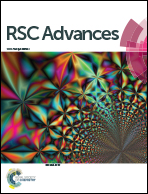Ultra-fast photonic curing of electrically conductive adhesives fabricated from vinyl ester resin and silver micro-flakes for printed electronics†
Abstract
To avoid high temperatures and long curing times, both of which are impractical in the manufacture of flexible printed electronic devices, we fabricated new electrically conductive adhesives using vinyl ester resin and silver micro-flakes and introduced an intense pulse of light to cure the adhesives under an ambient atmosphere at room temperature. The electrically conductive vinyl ester resin–silver micro-flake adhesives can absorb intense pulsed light, which initializes the double bonds in the resin to successfully achieve crosslinking and curing. This curing process, known as photonic curing, can be completed within a second under an ambient atmosphere at room temperature, over a large area. A typical curing time was 140 ms without any photosensitizers or photoinitiators in the adhesives. The cured conductive adhesives had low bulk resistivity, e.g., 7.54 × 10−6 Ω cm and high bonding strength, e.g., 6.75 MPa. Thus, the combination of photonic curing and electrically conductive vinyl ester resin–silver micro-flake adhesives has great potential for printed electronics, which require low temperature and fast processes based on flexible devices.


 Please wait while we load your content...
Please wait while we load your content...